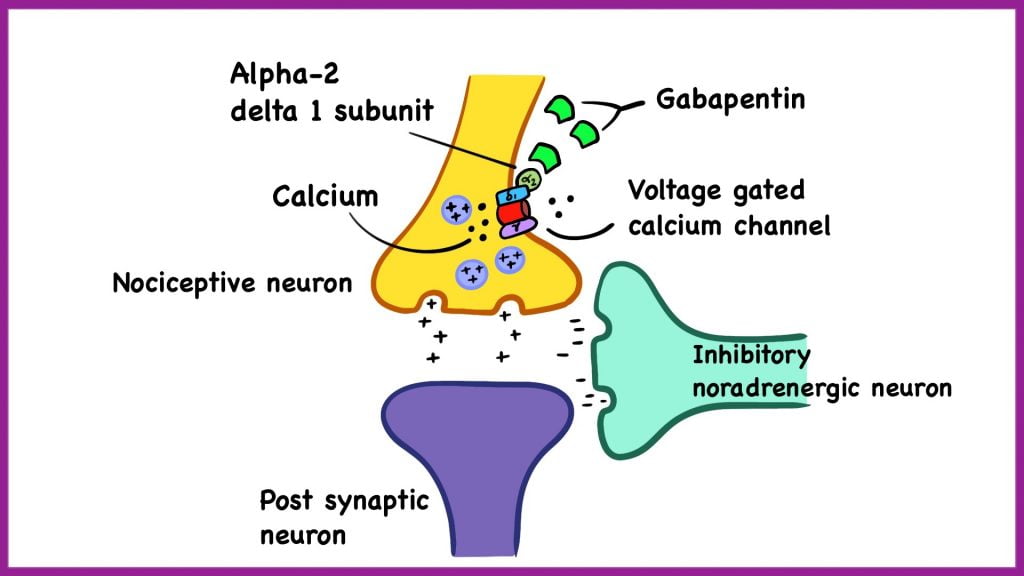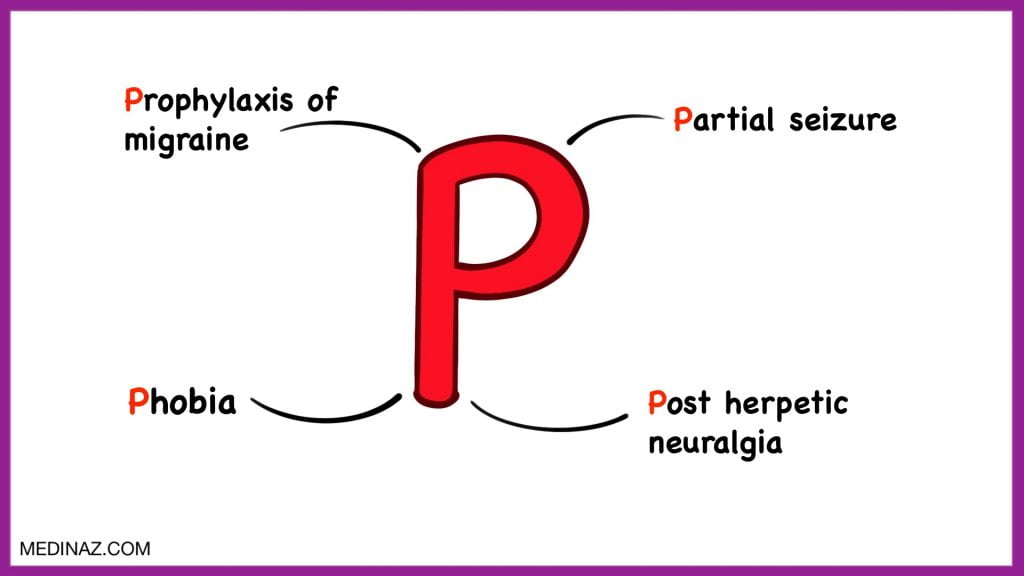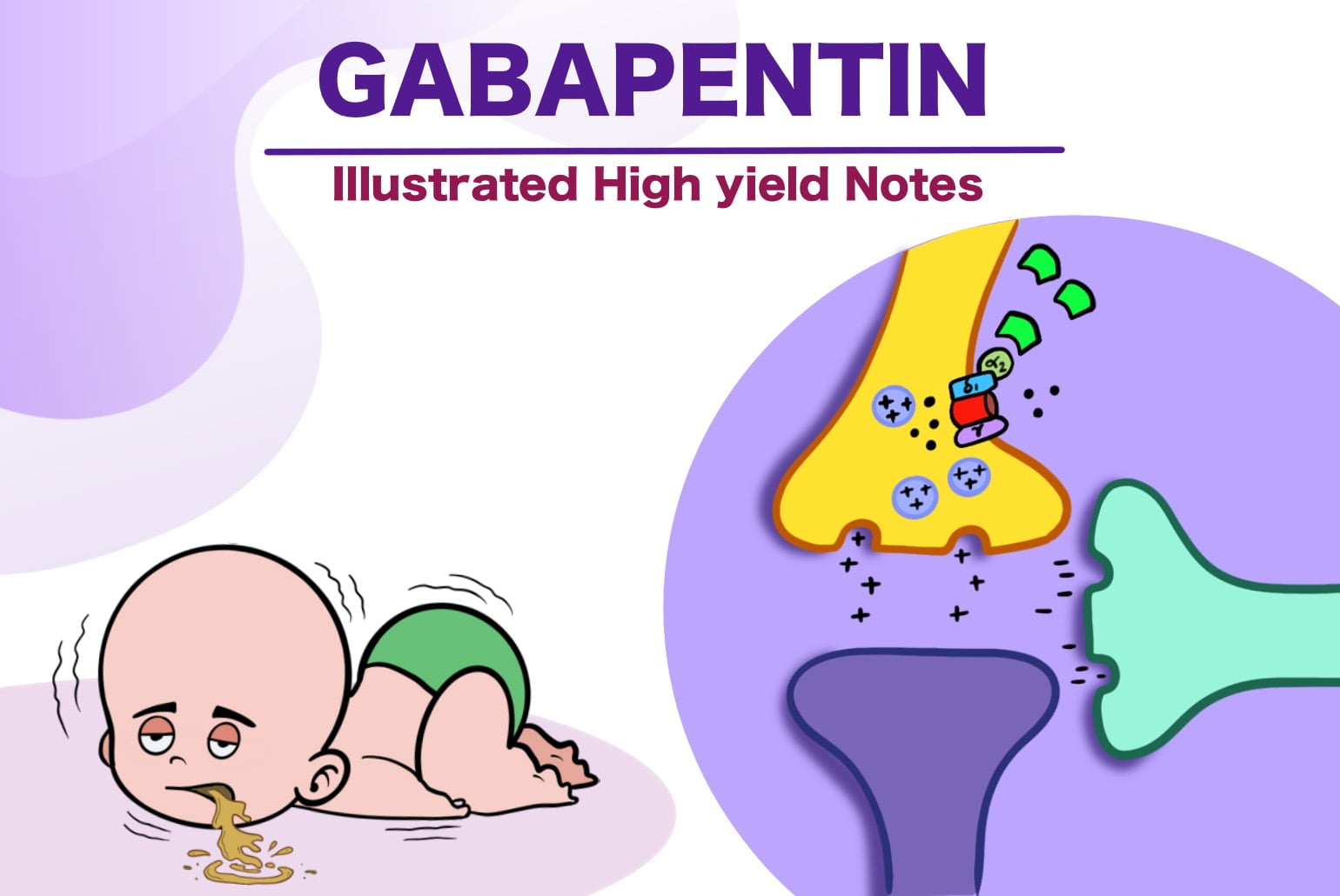High yield illustrated pharmacology notes of gabapentin side effects, mechanism of action, clinical uses, drug interaction, pharmacokinetics
Table of Contents
Overview
Gabapentin is an amino acid, an analog of GABA, that is effective against partial seizures.
Gabapentin was originally planned as a spasmolytic but it was found to be more effective as an antiseizure drug.
Pregabalin is another GABA analog and closely related to gabapentin. This drug has been approved for both antiseizure activity and for its analgesic properties.
Gabapentin Mechanism of action
Gabapentin does not act directly on GABA receptors in spite of their close structural resemblance to GABA.
They may, however, modify the synaptic or nonsynaptic release of GABA. An increase in brain GABA concentration is observed in patients receiving gabapentin.
Gabapentin is transported into the brain by the L-amino acid transporter.
Gabapentin binds avidly to the alpha-2-delta subunit of voltage-gated Ca2+ channels.
This appears to underlie the main mechanism of action, which is decreasing Ca2+ entry, with a predominant effect on presynaptic N-type channels.
A decrease in the synaptic release of glutamate provides the antiepileptic effect.
In addition, gabapentin may exert an analgesic effect by activating descending inhibitory noradrenergic pathways that regulate neurotransmission of pain signals in the dorsal horn of the spinal cord. (Ref)

Points to Remember
Gabapentin has no activity at GABAA or GABAB receptors of GABA uptake carriers of brain
Pharmacokinetics
Gabapentin is not metabolized and does not induce hepatic enzymes.
Absorption is nonlinear and dose-dependent at very high doses, but the elimination kinetics are linear.
Gabapentin does not bind to plasma proteins and is excreted unchanged through the kidneys.
Reduced dosing is required in renal disease
Half-life is 5-8 hours
Clinical uses of Gabapentin
Gabapentin is effective as an adjunct against partial seizures and generalized tonic-clonic seizures
Gabapentin is considered to be a first line drug for neuralgic pain due to diabetic neuropathy and postherpetic neuralgia.
It has some prophylactic effect in migraine and is an alternative drug for phobic states
It is also helpful to reduce pain related to multiple sclerosis
Gabapentin is also approved for the treatment of Bipolar disorder and Generalized anxiety disorder

Points to remember
- Gabapentin increases GABAergic transmission by increasing its synthesis and release.
- Its absorption from GIT is saturable, therefore it is safe even after overdosing
Gabapentin side effects
Dizziness and drowsiness
Somnolence
Fatigue
Weight gain
Uncoordinated movement
Dry mouth
Behavioural changes
Suicidal thoughts
Breathing difficulties with opioids and other CNS depressants
What type of drug is gabapentin?
Gabapentin is an anticonvulsant group of drug. Gabapentin decreases abnormal excitement in brain and helps to treat seizures. Gabapentin is the drug of choice for post herpetic neuralgia related pain.
Does gabapentin make you gain weight?
Weight gain and uncoordinated movement are possible side effects of gabapentin
What drugs cannot be taken with gabapentin?
Gabapentin can interact with Losartan, ethacrynic acid, phenytoin, mefloquine, magnesium oxide, cimetidine, naproxen, morphine and caffeine. Gabapentin use is contraindicated in patients with myasthenia gravis or myoclonus.
Is gabapentin a steroid?
Gabapentin is not a steroid. It is used as an anticonvulsant, sedative and anxiolytic to treat chronic pain syndromes, including neuropathic pain.
Is gabapentin an anti inflammatory for dogs?
Gabapentin is used in dogs to treat chronic pain, particularly of neuropathic origin. It appears to be most effective when combined with other types of analgesic agents like NSAIDs
Is gabapentin an anti inflammatory for cats?
Gabapentin is used in cats to treat chronic pain, particularly of neuropathic origin. It appears to be most effective when combined with other types of analgesic agents like NSAIDs
Reference:
Basic and Clinical Pharmacology; Bertram G. Katzung; 14th ed
The Pharmacological Basis of Therapeutics; Goodman & Gilman’s; 13th ed
Essentials of Medical Pharmacology; KD Tripathi; 7th ed
Review of Pharmacology; Garg & Gupta; 14th ed
A Visual Learning Platform





